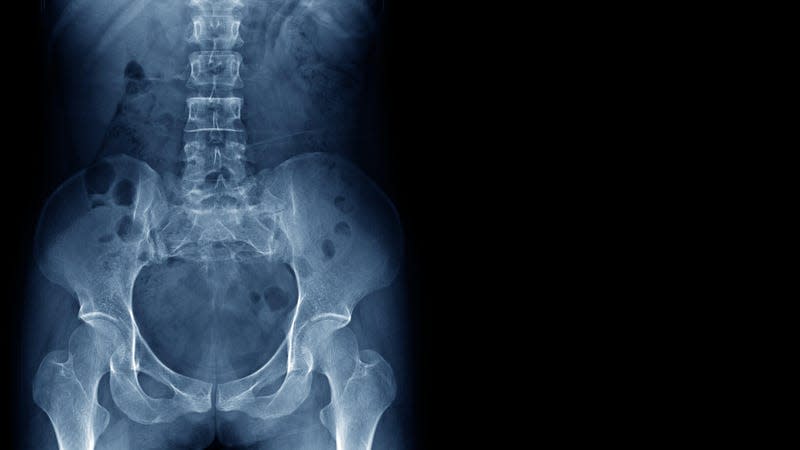An Experimental Drug May Help Prevent Bone Loss in Space

A x-ray image of a healthy human spine, hips, and pelvis.
A team of scientists say they may have found a new way to mitigate one of the most dangerous complications of space travel: the steady and inevitable loss of bone mass. In new research published this week, the team’s experimental treatment was able to promote bone growth in mice living aboard the International Space Station for at least nine weeks, seemingly with no adverse effects. More study will be needed to validate this treatment before it can be used in humans, however.
Fun as being nearly weightless might seem, the microgravity environment of space can have profoundly negative effects on our bodies if we stay up there too long. Our bones in particular actually depend on regular mechanical stress to stay healthy, much of which comes from fighting against Earth’s gravity. Without this stress, the body’s production of bone-building cells (called osteoblasts) starts to slow down. Coupled with the constant wearing down of our bones, this leads to progressive bone loss, which can then raise the risk of fractures during the mission and possibly even later on in life. Astronauts can lose up to 1% of their bone mass for every month they spend in space, while recovery back on Earth can take years following a long trip.
Read more
Is Star Wars trying to ditch its most hilariously inappropriate name?
The 2024 Nissan Z Is The Track Special For People Who Don’t Know About Other Cars
Tesla's Mega 98-Supercharger Location Runs In Part On A Diesel Generator: Report
The Dolphins are a tidal wave that left Russell Wilson feeling washed
The team’s results, published Monday in the journal Microgravity, are only the start of showing that this treatment can work as intended. And it will take more data to truly confirm the drug’s long-term safety and effectiveness. However, the authors are excited by the implications of their research and what it could mean for space travel.
“Our findings hold tremendous promise for the future of space exploration, particularly for missions involving extended stays in microgravity,” said lead corresponding author Chia Soo in a statement from UCLA.
Ideally, this treatment could even have other practical uses, the authors note. There are plenty of medical conditions on Earth that sap away our bone strength, such as severe osteoporosis. And it’s not far-fetched to hope that the team’s molecule could help prevent musculoskeletal deterioration more generally.
For now, the team is still analyzing the data from the mice that returned back to Earth—a feat in itself, since it was the first ever live animal return (“LAR Flight”) of mice accomplished by U.S. scientists.
More from Gizmodo
Neil deGrasse Tyson has a new favorite sci-fi movie to complain about
At $9,800, Is This 1970 Innocenti Mini 850 A Molto Bella Bargain?
That 42-6 trouncing should’ve been an eye-opener for Colorado
Starfield Player Followed Across The Galaxy By An Entire City
Sign up for Gizmodo's Newsletter. For the latest news, Facebook, Twitter and Instagram.

